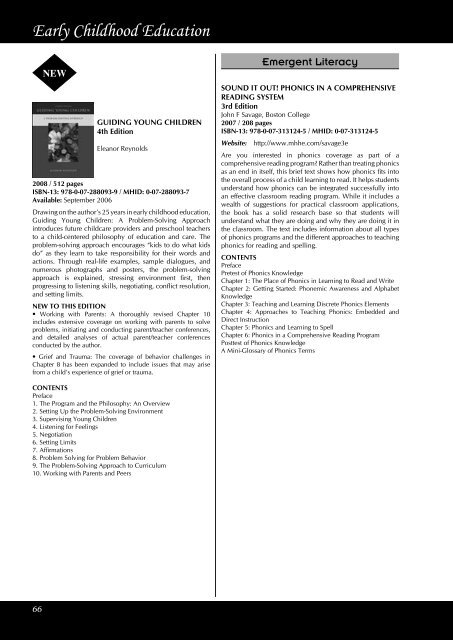table of contents - McGraw-Hill Books
table of contents - McGraw-Hill Books
table of contents - McGraw-Hill Books
You also want an ePaper? Increase the reach of your titles
YUMPU automatically turns print PDFs into web optimized ePapers that Google loves.
Early Childhood Education<br />
NEW<br />
GUIDING YOUNG CHILDREN<br />
4th Edition<br />
Eleanor Reynolds<br />
2008 / 512 pages<br />
ISBN-13: 978-0-07-288093-9 / MHID: 0-07-288093-7<br />
Available: September 2006<br />
Drawing on the author’s 25 years in early childhood education,<br />
Guiding Young Children: A Problem-Solving Approach<br />
introduces future childcare providers and preschool teachers<br />
to a child-centered philosophy <strong>of</strong> education and care. The<br />
problem-solving approach encourages “kids to do what kids<br />
do” as they learn to take responsibility for their words and<br />
actions. Through real-life examples, sample dialogues, and<br />
numerous photographs and posters, the problem-solving<br />
approach is explained, stressing environment first, then<br />
progressing to listening skills, negotiating, conflict resolution,<br />
and setting limits.<br />
NEW TO THIS EDITION<br />
• Working with Parents: A thoroughly revised Chapter 10<br />
includes extensive coverage on working with parents to solve<br />
problems, initiating and conducting parent/teacher conferences,<br />
and detailed analyses <strong>of</strong> actual parent/teacher conferences<br />
conducted by the author.<br />
• Grief and Trauma: The coverage <strong>of</strong> behavior challenges in<br />
Chapter 8 has been expanded to include issues that may arise<br />
from a child’s experience <strong>of</strong> grief or trauma.<br />
Emergent Literacy<br />
SOUND IT OUT! PHONICS IN A COMPREHENSIVE<br />
READING SYSTEM<br />
3rd Edition<br />
John F Savage, Boston College<br />
2007 / 208 pages<br />
ISBN-13: 978-0-07-313124-5 / MHID: 0-07-313124-5<br />
Website: http://www.mhhe.com/savage3e<br />
Are you interested in phonics coverage as part <strong>of</strong> a<br />
comprehensive reading program? Rather than treating phonics<br />
as an end in itself, this brief text shows how phonics fits into<br />
the overall process <strong>of</strong> a child learning to read. It helps students<br />
understand how phonics can be integrated successfully into<br />
an effective classroom reading program. While it includes a<br />
wealth <strong>of</strong> suggestions for practical classroom applications,<br />
the book has a solid research base so that students will<br />
understand what they are doing and why they are doing it in<br />
the classroom. The text includes information about all types<br />
<strong>of</strong> phonics programs and the different approaches to teaching<br />
phonics for reading and spelling.<br />
CONTENTS<br />
Preface<br />
Pretest <strong>of</strong> Phonics Knowledge<br />
Chapter 1: The Place <strong>of</strong> Phonics in Learning to Read and Write<br />
Chapter 2: Getting Started: Phonemic Awareness and Alphabet<br />
Knowledge<br />
Chapter 3: Teaching and Learning Discrete Phonics Elements<br />
Chapter 4: Approaches to Teaching Phonics: Embedded and<br />
Direct Instruction<br />
Chapter 5: Phonics and Learning to Spell<br />
Chapter 6: Phonics in a Comprehensive Reading Program<br />
Posttest <strong>of</strong> Phonics Knowledge<br />
A Mini-Glossary <strong>of</strong> Phonics Terms<br />
CONTENTS<br />
Preface<br />
1. The Program and the Philosophy: An Overview<br />
2. Setting Up the Problem-Solving Environment<br />
3. Supervising Young Children<br />
4. Listening for Feelings<br />
5. Negotiation<br />
6. Setting Limits<br />
7. Affirmations<br />
8. Problem Solving for Problem Behavior<br />
9. The Problem-Solving Approach to Curriculum<br />
10. Working with Parents and Peers<br />
66

















